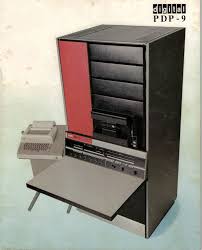Engineering:PDP-9
 | |
| Developer | Digital Equipment Corporation |
|---|---|
| Product family | Programmed Data Processor |
| Type | Minicomputer |
| Release date | 1966 |
| Units sold | 445 |
| Media | Paper tape |
| Platform | DEC 18-bit |
| Mass | 750 pounds (340 kg) |
| Predecessor | PDP-7 |
| Successor | PDP-15 |
The PDP-9, the fourth of the five 18-bit minicomputers produced by Digital Equipment Corporation, was introduced in 1966.[1]:P.10 A total of 445 PDP-9 systems were produced,[2] of which 40 were the compact, low-cost PDP-9/L units.[3]
History
The 18-bit PDP systems preceding the PDP-9 were the PDP-1, PDP-4 and PDP-7. Its successor was the PDP-15.
Hardware
The PDP-9, which is "two metres wide and about 75cm deep,"[4] is approximately twice the speed of the PDP-7. It was built using discrete transistors, and has an optional integrated vector graphics terminal. The PDP-9 has a memory cycle time of 1 microsecond, and weighs about 750 pounds (340 kg).[5](pp1-7-1-8) The PDP-9/L has a memory cycle time of 1.5 microseconds, and weighs about 900 pounds (410 kg).[6](p1-1, 15-8)
It was DEC's first microprogrammed machine.[7][5](p3-16)
A typical configuration included:[2]
- 300 cps paper tape reader
- 50 cps paper tape punch
- 10 cps console teleprinter, Model 33 KSR
Among the improvements of the PDP-9 over its PDP-7 predecessor were:
- the addition of status flags for reader and punch errors, thus providing added flexibility and for error detection[8]
- an entirely new design for multi-level interrupts, called the Automatic Priority Interrupt (API) option
- a more advanced form of memory management[9]
User/university-based research projects for extending the PDP-9 included:
- a hardware capability for floating-point arithmetic, at a time when machines in this price range used software for floating-point arithmetic[10]
- a PDP-9 controlled parallel computer[11]
Software
The system came with an OS that functioned as single-user keyboard monitor, called ADSS (ADvanced Software System).[12] DECsys provided an interactive, single-user, program development environment for Fortran and assembly language programs.[13]
Both FORTRAN II[2] and FORTRAN IV[14] were implemented for the PDP-9.
MUMPS was originally developed on the PDP-7, and ran on several PDP-9s at the Massachusetts General Hospital.
Sales
The PDP-7, of which 120 were sold,[1]:p.8 was described as "highly successful".[2] The PDP-9 sold 445 units. Both have submodels, the PDP-7A[NB 1] and the PDP-9/L,[NB 2] neither of which accounted for a substantial percentage of sales.[1][NB 3]
See also
- Programmed Data Processor
- PDP-15 - successor to the PDP-9
Notes
References
- ↑ 1.0 1.1 1.2 DIGITAL EQUIPMENT CORPORATION - Nineteen Fifty-Seven To The Present. Digital Equipment Corporation. 1975. http://s3data.computerhistory.org/pdp-1/dec.digital_1957_to_the_present_(1978).1957-1978.102630349.pdf.
- ↑ 2.0 2.1 2.2 2.3 "RI Computer Museum, DEC PDP-9, System Number 319". https://www.ricomputermuseum.org/collections-gallery/equipment/dec-pdp-9.
- ↑ ."The Early Architectures of DEC". http://www.quadibloc.com/comp/pan07.htm.
- ↑ "David Millson - 50 years". https://50years.latrobe/david-millsom.
- ↑ 5.0 5.1 PDP-9 Maintenance Manual, Volume 1. April 1972. http://www.bitsavers.org/pdf/dec/pdp9/F-97_PDP-9_MaintMan_Apr72.pdf.
- ↑ PDP-9/L User Handbook. June 1968. http://www.bitsavers.org/pdf/dec/pdp9/pdp9l/DEC-9L-GRVA-D_PDP9L_Hbk.pdf.
- ↑ C. Gordon Bell; Gerald Butler; Robert Gray; John E. McNamara; Donald Vonada; Ronald Wilson (1978). "Chapter 6: The PDP-1 and Other 18-bit Computers". Computer Engineering: A DEC View of Hardware Systems Design. Digital Press. pp. 154–155. ISBN 0-932376-00-2. https://books.google.com/books?id=SDOoBQAAQBAJ&pg=PA154.
- ↑ Bob Supnik. "Architectural Evolution in DEC's 18b Computers". http://www.soemtron.org/downloads/decinfo/architecture18b-08102006.pdf.
- ↑ "PDP 9 Simulator Configuration". https://github.com/parsa/simh/wiki/PDP-9-Simulator-Configuration.
- ↑ Ben Milton Huey (1969). Design of a floating point processor for the PDP-9 computer. University of Arizona. http://arizona.openrepository.com/arizona/handle/10150/318186.
- ↑ Wokhlu, Roop Krishen (1969). The logic design of a PDP-9 controlled parallel computer. http://arizona.openrepository.com/arizona/handle/10150/347638.
- ↑ Digital Equipment Corporation. "Software Product Description, ADSS-B/F-15, Version SC, Advanced Software System, B/F". http://www.bitsavers.org/pdf/dec/spd/17.06.00_7608_ADSS-B_F-15_5C.pdf.
- ↑ Bob Supnik (19 June 2006). "Technical Notes on DECsys". http://simh.trailing-edge.com/docs/decsys.pdf.
- ↑ "User Manual - Linkage - PDP-9 Facilities". Carnegie-Mellon University Hybrid Computation Laboratory. September 1968. http://www.silogic.com/Athena/Hybrid%20Lab/1968%20CMU%20Hybrid%20Lab%20-%20Linkage%20-%20PDP-9%20Facilities.pdf.
 |



